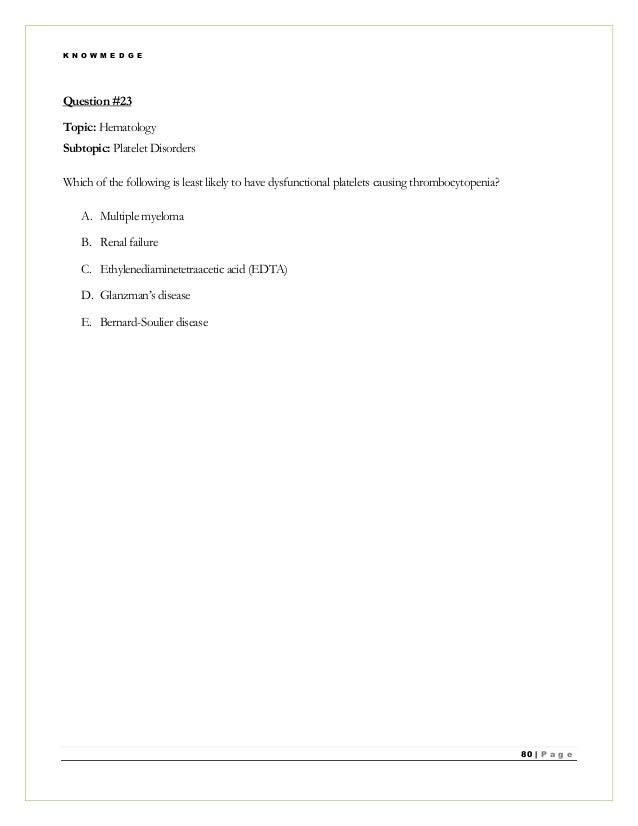

As the vegetation grows on the affected valve, the patient will develop signs and symptoms of heart failure, which is a result of the insufficient valve. Patients with infective endocarditis may initially experience nonspecific symptoms such as fevers, malaise, and anorexia, as seen in this patient. aureus is responsible for 80-90% of tricuspid valve endocarditis.
NBME SAMPLE QUESTIONS ANSWERS SKIN
aureus) is a common skin pathogen and is seen often with intravenous drug use. This patient is at high risk of tricuspid endocarditis given his intravenous drug use. TEE has a 90% sensitivity for detecting vegetation. Transesophageal echocardiogram (TEE) is the diagnostic test of choice in a patient with a high probability of endocarditis. The patient is presenting with signs of decompensated heart failure, which is a result of infective endocarditis. transthoracic echocardiogram of the heart Answer and Explanation transesophageal echocardiogram of the heartĮ. The most accurate diagnostic test to confirm this patient’s diagnosis isĭ. Blood cultures over the next 2 days grow Staphylococcus aureus. There is pitting pedal edema extending into his mid-thigh. A new holosystolic cardiac murmur at the left lower sternal border is observed. Physical examination reveals distended jugular veins bilaterally and clear lungs bilaterally. Vital signs reveal a blood pressure of 150/80 mmHg, heart rate of 105/min, respiratory rate of 25/min, oxygen saturation of 96% on room air, and temperature of 38.9☌ (102☏). He does report a significant history of intravenous drug use. There is no known family history of heart disease. The patient had no known prior medical problems. Prior to the current complaints, he has been experiencing fevers, malaise, and anorexia for one week.
NBME SAMPLE QUESTIONS ANSWERS FREE
Your First Free NBME Sample QuestionĪ 35-year-old male presents to the emergency department with rapidly progressive dyspnea, orthopnea, paroxysmal nocturnal dyspnea, and peripheral edema over the last 2 days. Below is a free NBME sample question so you can see first-hand what we mean. That’s why we have high-yield NBME practice questions written and screened by high-performing physician authors that are updated on a regular basis to ensure our SmartBanks stay up-to-date with exam blueprint changes. At TrueLearn, we understand that it’s all about the content. *If you really want your mind blown, consider that even the protein subunits that make up that 1/3 of a ribosome are themselves initially synthesized in the cytosol later, they are transported back into the nucleus via the nuclear pore.See why TrueLearn is a trusted resource for thousands of medical students and residents. “The synthesis of virtually all proteins in the cell begins on ribosomes in the cytosol.” ( Essential Cell Biology, Alberts et al., 2014, p.

Here’s a nice schematic showing the flow of proteins from initial synthesis to final destinations: In the absence of this signal, a protein will remain in its “default” home of the cytosol. The signal sequence tells other cytosolic proteins, “Hey! Take me (and the rest of the peptide of which I am part) to the ER!” Proteins ultimately destined for the ER contain an unimaginatively named string of amino acids known as “signal sequence,” which, for the purposes of the Step 1, is always at the N-terminus.

Ribosomes, which are mostly just rRNA (~2/3 rRNA + 1/3 protein*, by weight), are assembled in the nucleus but only do their stuff once they get to the cytoplasm.įor a protein to leave its original hometown of the cytosol and become a resident of the nucleus or, sayyyyyy, the endoplasmic reticulum, it needs to have a little string of amino acids which shout “I belong in the nucleus!” or “I belong in the endoplasmic reticulum!” That’s where all ribosomes reside, after all. The synthesis of virtually all proteins (mRNA->peptide) occurs in the cytoplasm.


 0 kommentar(er)
0 kommentar(er)
